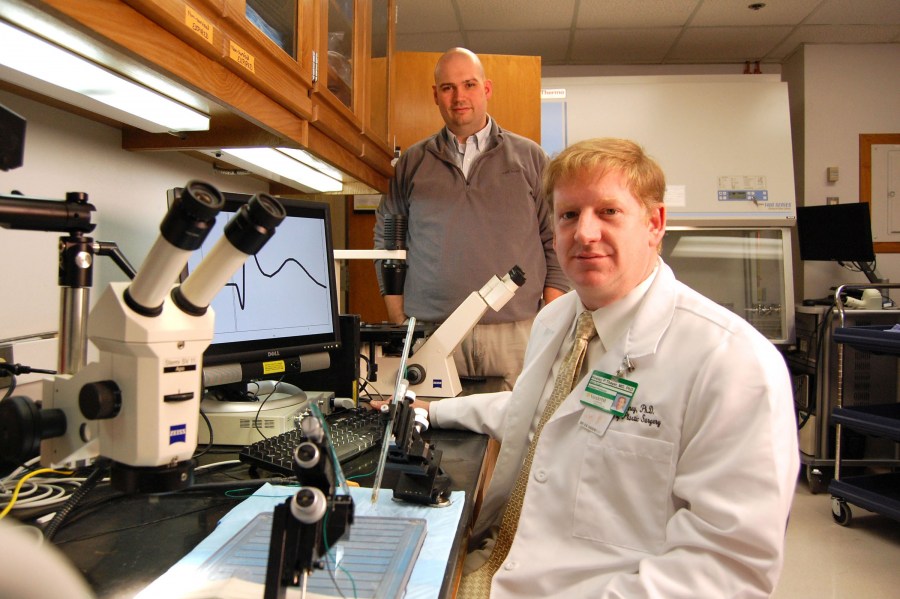
Wesley Thayer, M.D., Ph.D., foreground, and Kevin Sexton, M.D., are investigating ways to repair nerves following a traumatic injury. (photo by Jeni Slone)
New technique could speed repair of damaged nerves
Surgeons have been successfully reattaching limbs since the 1960s, but returning full function to the severed arm or leg remains the stuff of science fiction novels.
Investigators at Vanderbilt University Medical Center hope their research will one day enable surgeons to apply a simple solution that begins to repair the nerves immediately while the limb is being reattached in the operating room.
Using a calcium-free polyethylene glycol (PEG) solution, Wesley Thayer, M.D., Ph.D., and colleagues from the Department of Plastic Surgery, were able to repair a severed nerve in a rat, returning movement in the leg in just minutes.
They were also able to bridge gaps in injured nerves using the new approach.
Thayer, assistant professor of Plastic Surgery and Orthopaedic Surgery, presented his work at the American Association for Hand Surgery annual meeting in January.
Nerves can naturally repair themselves by regenerating and regrowing over time. Such repair in smaller extremities, such as fingers, can occur more easily because the distance between the nerves and its target is short.
However, when an entire limb is cut or damaged near the shoulder, it can take a year for nerves to regenerate at a rate of 1 millimeter per day.
Unfortunately, by that time, muscle atrophy has set in, severely limiting any restoration of nerve function.
This new approach shortens the time for repair and regeneration, and has also been shown to work even days after the nerves are cut. These developments may one day help traumatic injury survivors who previously had little to no options in repairing nerve damage.
The PEG solution is applied to both ends of the severed nerve after bathing the nerves in a calcium-free solution. This solution acts to keep the nerve channel open, and the PEG brings the severed nerves together.
A follow-up calcium solution works to bind the process together. In previous attempts to return nerve function, the initial PEG solution contained calcium, but results were poor.
After several attempts, the research team left calcium out of the PEG, which immediately led to successful outcomes.
“We believe the calcium in the PEG solution hampered nerve repair by too quickly sealing the nerves in an unrepaired state,” said Thayer.
“By removing the calcium in the early steps, we allow the nerve channel to remain effectively open before binding all of the critical elements in place,” he said.
Vanderbilt engineers are working with Thayer to develop a device that more precisely administers the PEG solution in the operating room.
Launched in 2011, the Vanderbilt Initiative of Surgery and Engineering (VISE) has already developed new technologies in soft-tissue image-guided procedures that enable surgeons to see exactly where critical structures, such as blood vessels and nerves, are located.
In February, the Association for Academic Surgery (AAS) awarded Kevin Sexton, M.D., a research fellow who is working with Thayer, the Outstanding Resident Research Award in Basic Science and Best Manuscript by an AAS New Member prize for their paper on using polymers to bridge nerve gaps resulting from an injury.













